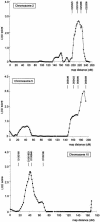Genomewide search in familial Paget disease of bone shows evidence of genetic heterogeneity with candidate loci on chromosomes 2q36, 10p13, and 5q35
- PMID: 11555792
- PMCID: PMC1274352
- DOI: 10.1086/323798
Genomewide search in familial Paget disease of bone shows evidence of genetic heterogeneity with candidate loci on chromosomes 2q36, 10p13, and 5q35
Abstract
Paget disease of bone (PDB) is a common disorder characterized by focal abnormalities of increased and disorganized bone turnover. Genetic factors are important in the pathogenesis of PDB, and previous studies have shown that the PDB-like bone dysplasia familial expansile osteolysis is caused by activating mutations in the TNFRSF11A gene that encodes receptor activator of nuclear factor kappa B (RANK); however, linkage studies, coupled with mutation screening, have excluded involvement of RANK in the vast majority of patients with PDB. To identify other candidate loci for PDB, we conducted a genomewide search in 319 individuals, from 62 kindreds with familial PDB, who were predominantly of British descent. The pattern of inheritance in the study group as a whole was consistent with autosomal dominant transmission of the disease. Parametric multipoint linkage analysis, under a model of heterogeneity, identified three chromosomal regions with LOD scores above the threshold for suggestive linkage. These were on chromosomes 2q36 (LOD score 2.7 at 218.24 cM), 5q35 (LOD score 3.0 at 189.63 cM), and 10p13 (LOD score 2.6 at 41.43 cM). For each of these loci, formal heterogeneity testing with HOMOG supported a model of linkage with heterogeneity, as opposed to no linkage or linkage with homogeneity. Two-point linkage analysis with a series of markers from the 5q35 region in another large kindred with autosomal dominant familial PDB also supported linkage to the candidate region with a maximum LOD score of 3.47 at D5S2034 (187.8 cM). These data indicate the presence of several susceptibility loci for PDB and identify a strong candidate locus for the disease, on chromosome 5q35.
Figures


References
Electronic-Database Information
-
- Ensembl database, http://www.ensembl.org (for identification of candidate genes in loci of interest)
-
- Linkage Designer Software, http://www.uia.ac.be/dnalab/ld.html (for binning alleles and inheritance checking)
-
- Marshfield database, http://research.marshfieldclinic.org/genetics (for marker order and genetic distance between markers)
-
- Online Mendelian Inheritance in Man (OMIM): http://www.ncbi.nlm.nih.gov/Omim (for PDB [MIM 167250 and MIM 602080] and FEO [MIM 174810])
-
- University of Aberdeen, http://www.abdn.ac.uk/medicine_therapeutics/bone/bone.hti (for full details of pedigrees included in the present study)
References
-
- Barker DJ (1984) The epidemiology of Paget's disease of bone. Br Med Bull 40:396–400 - PubMed
-
- Cooper C, Shafheutle K, Dennison K, Guyer P, Barker DJ (1999) The epidemiology of Paget's disease in Britain: is the prevalence decreasing? J Bone Miner Res 14:192–197 - PubMed
-
- Good D, Busfield F, Duffy D, Lovelock PK, Kesting JB, Cameron DP, Shaw JT (2001) Familial Paget's disease of bone: nonlinkage to the PDB1 and PDB2 loci on chromosomes 6p and 18q in a large pedigree. J Bone Miner Res 16:33–38 - PubMed
-
- Haslam SI, Van Hul W, Morales-Piga A, Balemans W, San-Millan J, Nakatsuka K, Willems P, Haites NE, Ralston SH (1998) Paget's disease of bone: evidence for a susceptibility locus on chromosome 18q and for genetic heterogeneity. J Bone Miner Res 13:911–917 - PubMed
Publication types
MeSH terms
Substances
Associated data
- Actions
- Actions
- Actions
LinkOut - more resources
Full Text Sources
Other Literature Sources
Medical

